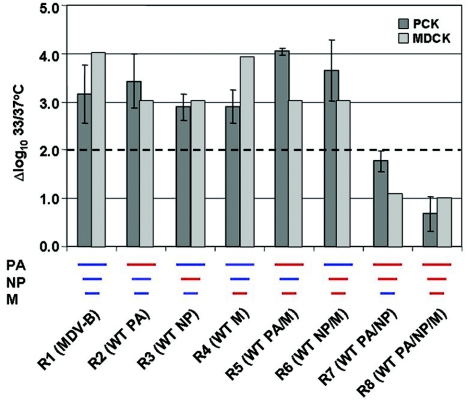FIG. 1.
Temperature sensitivity of recombinant viruses. Recombinant viruses were generated by cotransfection of eight plasmids. R1 (rMDV-B) was constructed by transfection of eight plasmids corresponding to the consensus sequence of ca B/Ann Arbor/1/66. The gene segment listed below each set of bars denotes the recombinant virus designation (see Table 3) and wt gene segment(s) in the recombinant virus containing wt consensus nucleotide replacements. The colored bars beneath each label represent the derivation of the PA, NP, and M gene segments in each recombinant (red, wt residues; blue, MDV-B). Each recombinant virus was titrated in PCK cells (dark gray) by TCID50 and in MDCK cells (light gray) by plaque assay at 33 and 37°C. The difference in the log10 titer at these two temperatures (titer log10 33°C-titer log10 37°C) is displayed on the y axis. The dotted horizontal line represents a difference in which the titer at 33°C is 2.0 log10 greater than the titer at 37°C. The error bars represent ± the standard deviation from the mean for the TCID50 assays; the light gray bars (plaque assay) represent a typical experiment.

